Beef Bulgogi
This post may contain affiliate links. Read my full disclosure policy.
Add some sizzle to your weeknights with this easy beef bulgogi recipe—a Korean barbecue favorite!
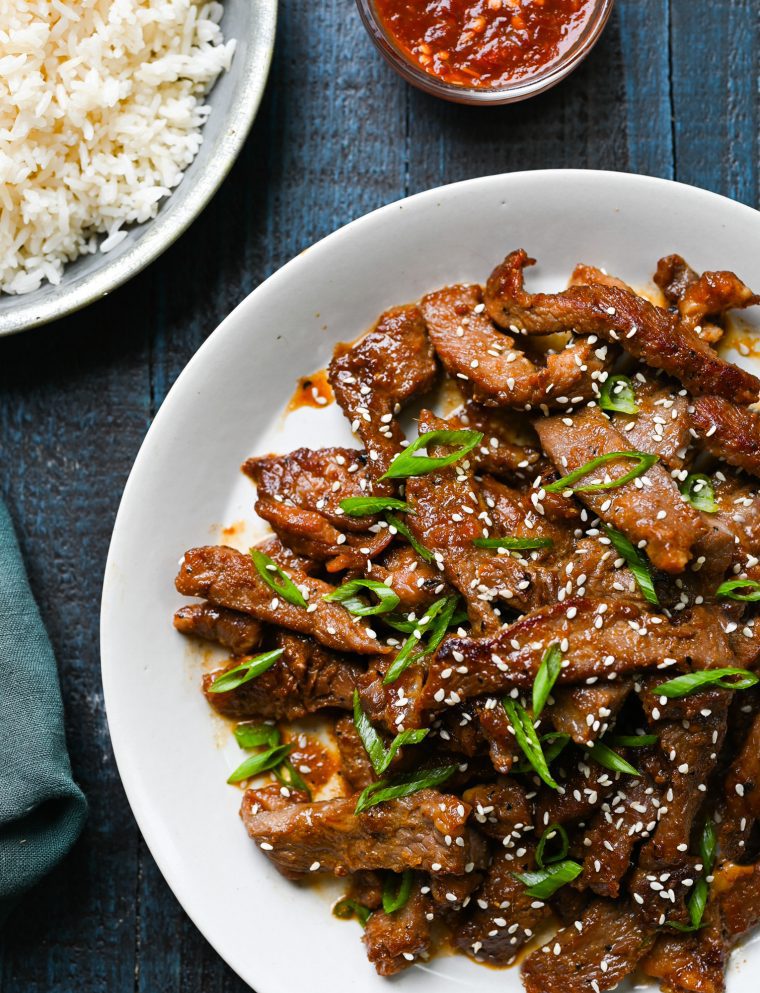
Bulgogi, pronounced bool-goh-gee, is a popular Korean barbecue dish that translates to “fire meat.” It’s made of thinly sliced marinated meat, typically beef, that’s grilled on a barbecue or stovetop griddle. Despite its name, bulgogi is not really spicy — “fire” refers to the hot cooking surface. In many Korean restaurants, tables are outfitted with grills in the center so customers can cook the bulgogi meat themselves and eat it straight from the grill. Bulgogi is typically served with steamed rice, lettuce wraps, chili sauce, and other traditional Korean accompaniments.
Making bulgogi at home is surprisingly easy. In this version, adapted from Cooks Illustrated, I marinate well-marbled ribeye in a mixture of soy sauce, brown sugar, sesame oil, garlic, shallot, ginger, and red pepper flakes. Because the meat is thinly sliced, it only needs one hour to marinate (although it’s fine to leave it overnight, too). Instead of grilling the meat, which can be tricky unless you have a flat-top grill, I cook it in a cast iron or nonstick pan. Heads up: the mouthwatering smell of bulgogi sizzling on the stove will have your family circling the kitchen like hungry wolves. Conveniently, it cooks in under 10 minutes, so no one will have to wait too long!
Table of Contents
“Made it to the recipe but doubled the marinade as one reviewer suggested. Wow! This recipe is delicious!! Served it with some Jasmine rice and I can’t wait to make it again!!”
What You’ll Need To Make Beef Bulgogi
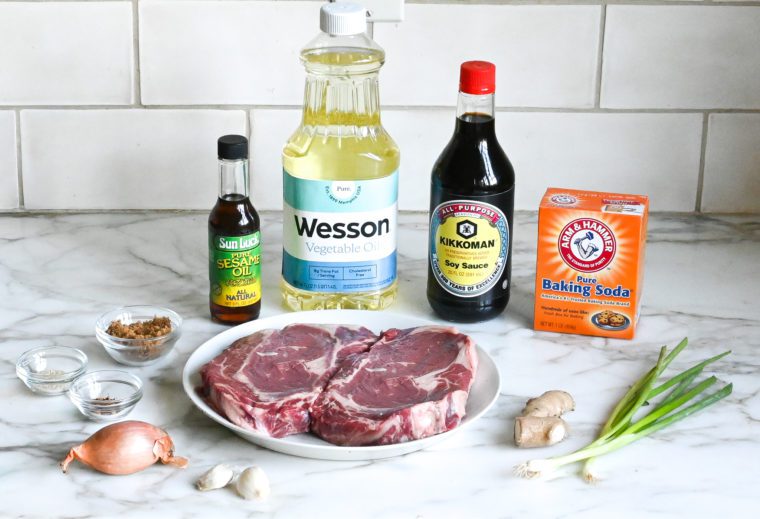
- Ribeye Steaks: Bulgogi can be made with many cuts of meat, including ribeye, short ribs, sirloin, or tenderloin. Ribeye is ideal as it’s well-marbled with fat, making it tender and tasty.
- Baking Soda: Tenderizes the beef and also helps with browning and caramelization.
- Vegetable Oil: The neutral base of the marinade.
- Asian Sesame Oil: A small amount adds a nutty, rich flavor to the marinade.
- Soy Sauce: Flavors the marinade with umami and saltiness, which deeply seasons the meat.
- Dark Brown Sugar: Adds sweetness to the marinade, balancing the salty flavors of the soy sauce and enhancing the caramelization of the meat when cooked.
- Garlic, Shallots, and Ginger: These aromatics contribute depth and complexity to the marinade, infusing the meat with traditional Korean flavors.
- Crushed Red Pepper Flakes: Introduce a hint of heat to the dish.
- Scallions: A fresh, crisp garnish that adds both color and a mild oniony flavor to complement the rich meat.
- Sesame Seeds: Finishes the dish with a slight crunch and reinforces the sesame flavor in the dish.
- Jump to the printable recipe for precise measurements
Step-By-Step Instructions
If time allows, place the steaks on a large plate and freeze until semi-firm, about 35 minutes. This makes the steaks much easier to slice. Slice the steaks into ¼-inch-thick slices.
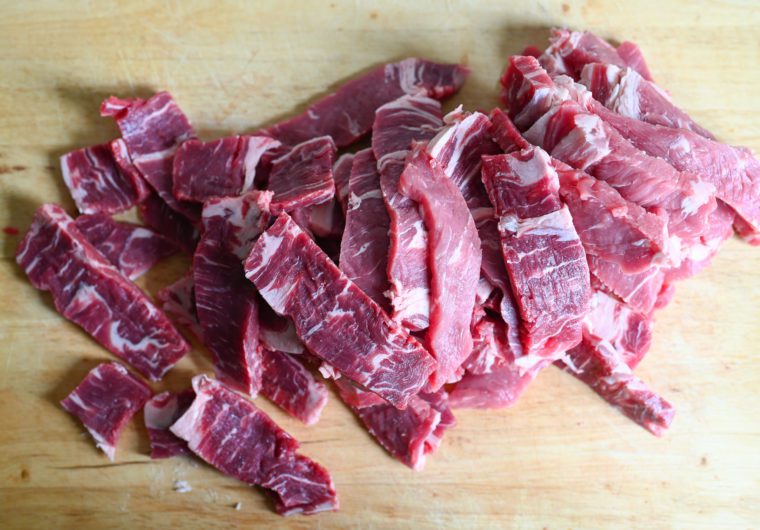
Combine 1½ tablespoons of water and the baking soda in a medium bowl. The baking soda acts as a tenderizer, and also helps with browning and caramelization. Add the beef slices and toss to coat. Let sit at room temperature for 5 minutes.
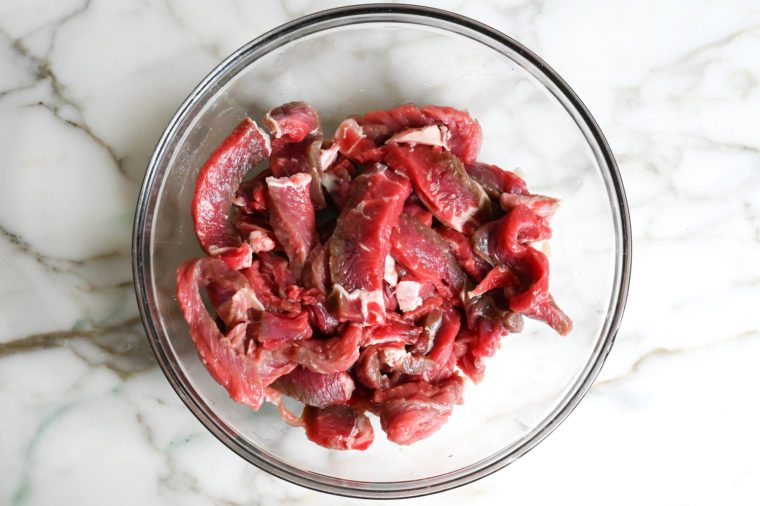
Meanwhile, in a mini food processor or blender, combine the vegetable oil, sesame oil, soy sauce, sugar, garlic, shallot, ginger, and red pepper flakes.
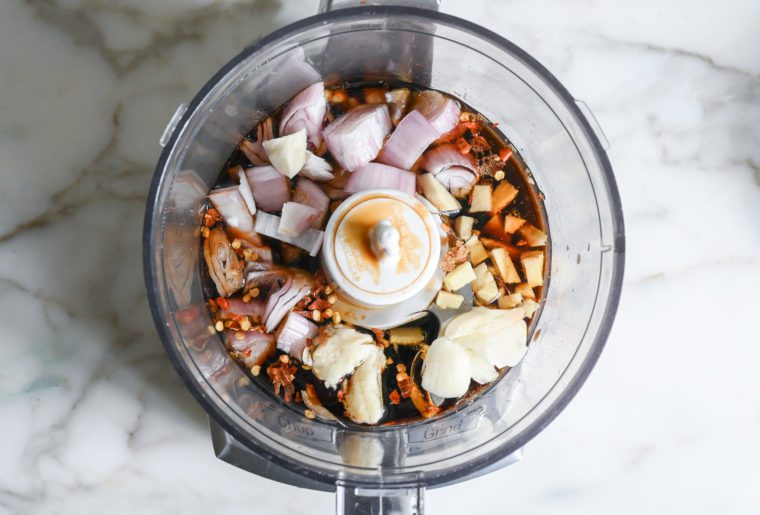
Process until smooth.

Pour the mixture over the beef and toss to coat evenly. Cover with plastic wrap and marinate in the refrigerator for at least 1 hour or overnight.
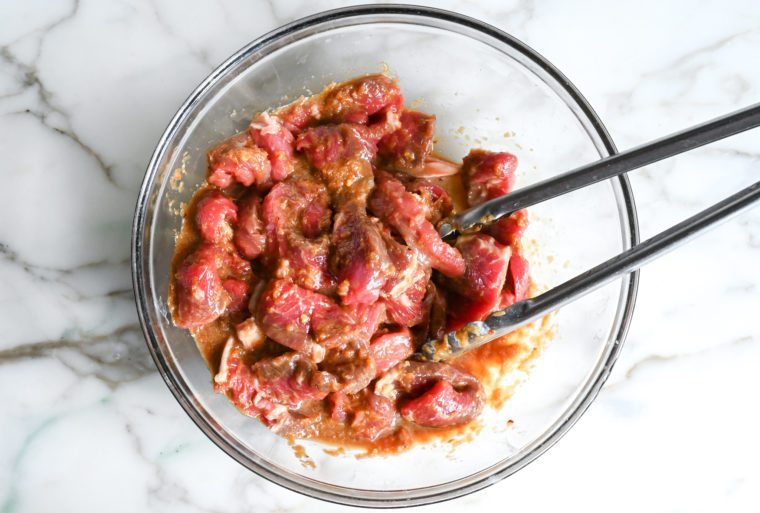
Turn on the exhaust fan. In a large (12-inch) cast iron or nonstick skillet over medium-high heat, heat the remaining 2 teaspoons of oil until very hot and shimmering. Your pan should be hot enough so that you hear a sizzling sound as the meat touches the pan. This helps the exterior of the meat caramelize while keeping the inside tender and juicy. Add half of the beef slices in a single layer and cook, without stirring, until browned on one side, 2 to 3 minutes.
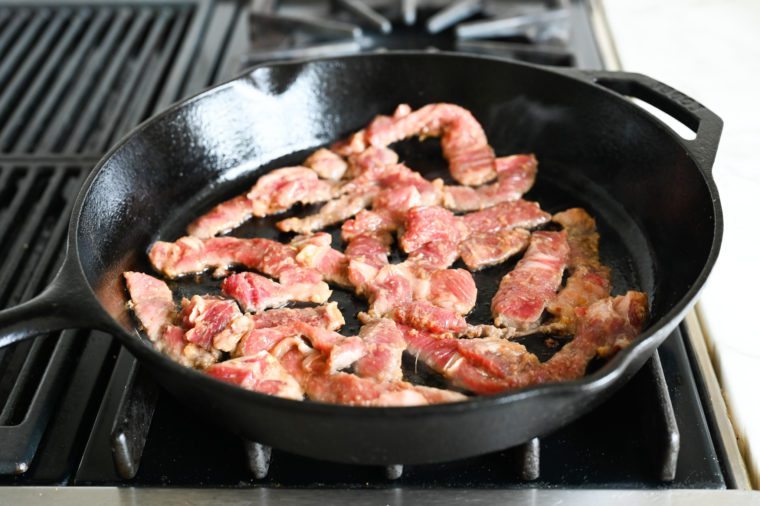
Stir the meat and continue stir-frying until the beef is just cooked through, 1 to 2 minutes longer. Transfer the beef to a serving platter and cover to keep warm; repeat with the remaining beef (no need to add more oil to the pan), adding any marinade left in the bowl to the pan right before stirring the meat.
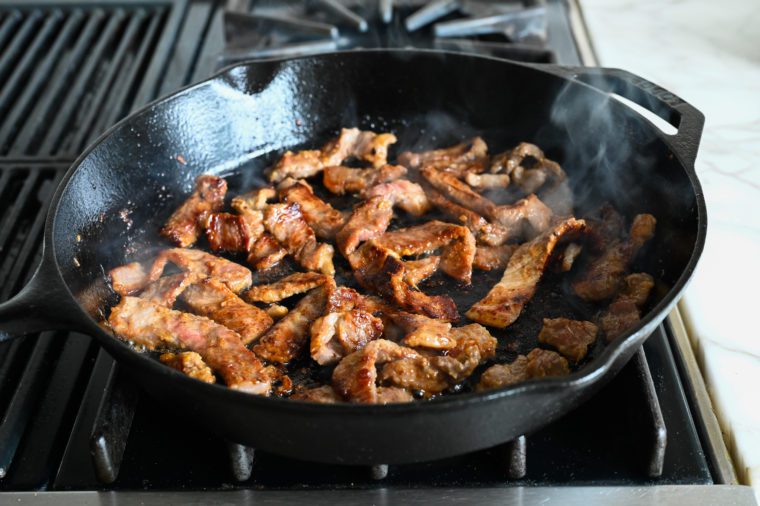
Transfer the second batch of beef to the serving platter and sprinkle with the scallion greens and sesame seeds. Serve immediately.
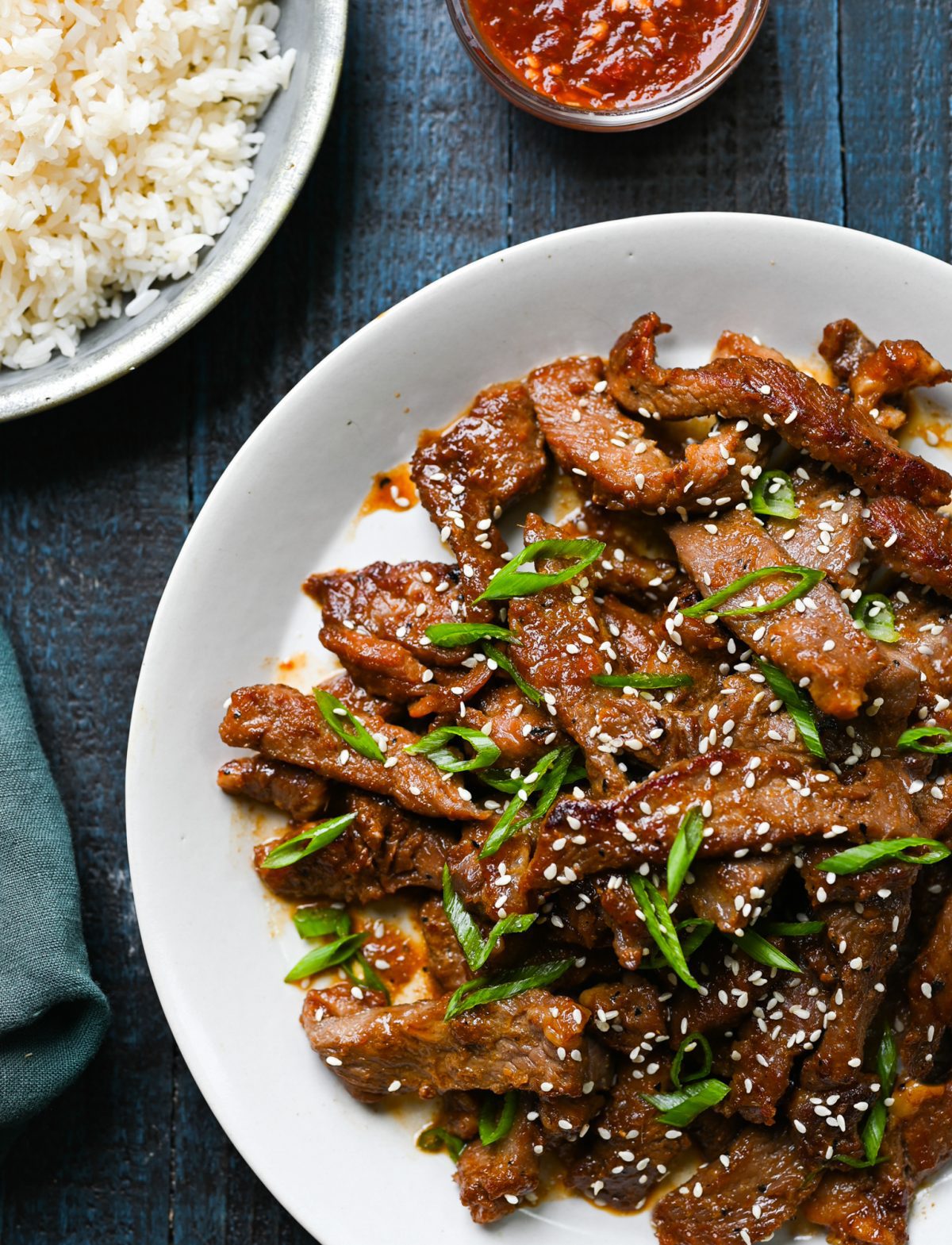
Video Tutorial
You May Also Like
Beef Bulgogi
Add some sizzle to your weeknights with this easy beef bulgogi recipe—a Korean barbecue favorite!
Ingredients
- 1¾-2 pounds ribeye steaks
- Heaping ¼ teaspoon baking soda
- 1½ tablespoons vegetable oil, plus 2 teaspoons more for cooking
- 1½ teaspoons Asian sesame oil
- ¼ cup soy sauce
- 3 tablespoons (packed) dark brown sugar
- 2 cloves garlic, roughly chopped
- 1 small shallot, roughly chopped
- 1 tablespoon roughly chopped fresh ginger, from a 1-inch knob (see note)
- Heaping ¼ teaspoon crushed red pepper flakes
- 2 scallions, dark green parts only, thinly sliced, for serving
- 1 teaspoon sesame seeds, for serving
Instructions
- If time allows, place the steaks on a large plate and freeze until semi-firm, about 35 minutes (this makes them easier to slice). Slice the steaks into ¼-inch-thick slices.
- Combine 1½ tablespoons of water and the baking soda in a medium bowl. Add the beef slices and toss to coat. Let sit at room temperature for 5 minutes.
- Meanwhile, in a mini food processor or blender, combine the 1½ tablespoons vegetable oil, sesame oil, soy sauce, sugar, garlic, shallot, ginger, and red pepper flakes; process until smooth. Pour the mixture over the beef and toss to coat evenly. Cover with plastic wrap and marinate in the refrigerator for at least 1 hour or overnight.
- Turn on the exhaust fan. In a large (12-inch) cast iron or nonstick skillet over medium-high heat, heat the remaining 2 teaspoons of oil until very hot and shimmering. Add half of the beef slices in a single layer and cook, without stirring, until browned on one side, 2 to 3 minutes. Stir the meat and continue stir-frying until the beef is just cooked through, 1 to 2 minutes longer. Transfer the beef to a serving platter and cover to keep warm; repeat with the remaining beef (no need to add more oil to the pan), adding any marinade left in the bowl to the pan right before stirring the meat. Transfer the second batch of beef to the serving platter and sprinkle with the scallion greens and sesame seeds. Serve immediately.
- Note: Check out easy guidance on how to peel, grate, and chop fresh ginger here.
Pair with
Nutrition Information
Powered by ![]()
- Per serving (4 servings)
- Calories: 707
- Fat: 55 g
- Saturated fat: 21 g
- Carbohydrates: 14 g
- Sugar: 11 g
- Fiber: 1 g
- Protein: 44 g
- Sodium: 1,073 mg
- Cholesterol: 154 mg
This website is written and produced for informational purposes only. I am not a certified nutritionist and the nutritional data on this site has not been evaluated or approved by a nutritionist or the Food and Drug Administration. Nutritional information is offered as a courtesy and should not be construed as a guarantee. The data is calculated through an online nutritional calculator, Edamam.com. Although I do my best to provide accurate nutritional information, these figures should be considered estimates only. Varying factors such as product types or brands purchased, natural fluctuations in fresh produce, and the way ingredients are processed change the effective nutritional information in any given recipe. Furthermore, different online calculators provide different results depending on their own nutrition fact sources and algorithms. To obtain the most accurate nutritional information in a given recipe, you should calculate the nutritional information with the actual ingredients used in your recipe, using your preferred nutrition calculator.
Gluten-Free Adaptable Note
To the best of my knowledge, all of the ingredients used in this recipe are gluten-free or widely available in gluten-free versions. There is hidden gluten in many foods; if you're following a gluten-free diet or cooking for someone with gluten allergies, always read the labels of your ingredients to verify that they are gluten-free.

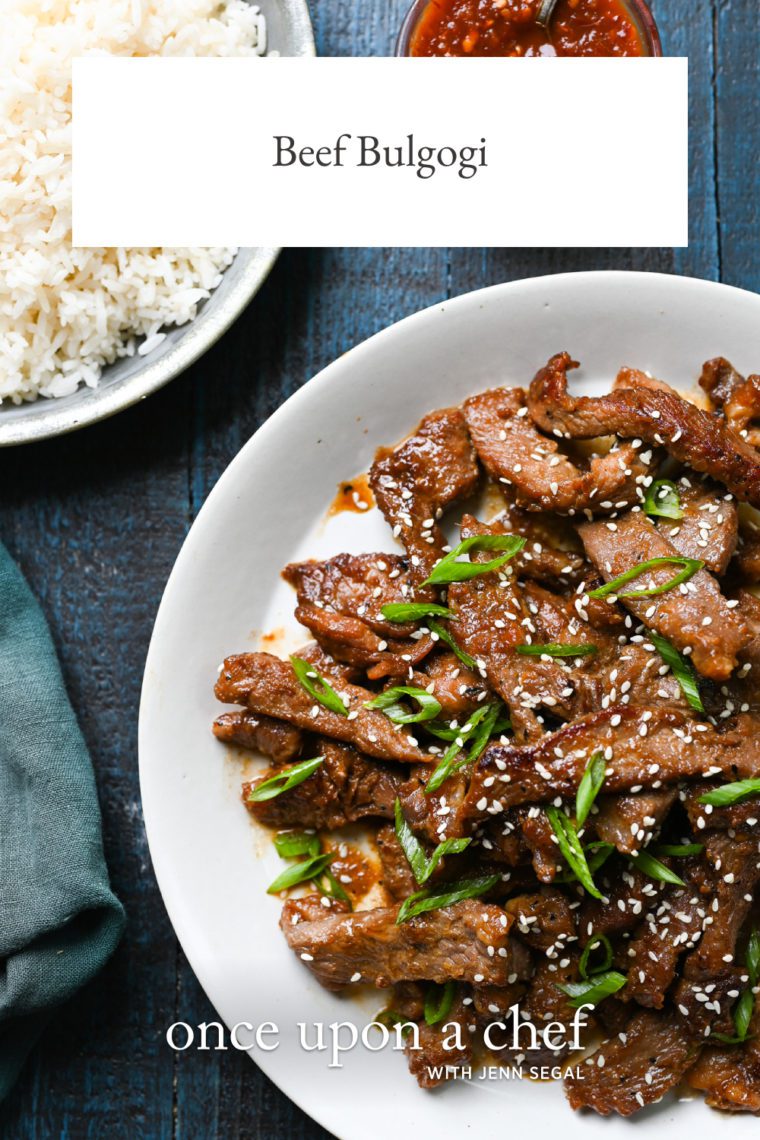

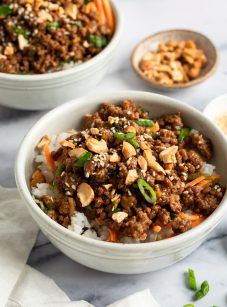
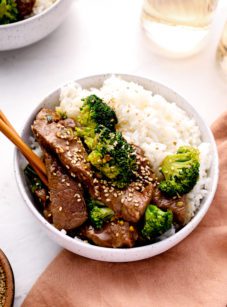
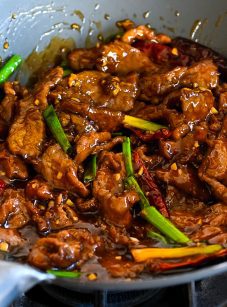

This is an excellent recipe. Very tasty and a bit spicy, which you can control.
Hi Jenn, I love all your recipes. My husband always asks “Is this your girlfriend’s recipe?” and I always say yes! I was wondering if this could be made not using beef? If so, what type of meat and cut would you use, my daughter doesn’t eat beef. Thank you
Aww…I love that your husband asks that! I think this would work with sliced chicken thighs. I’d love to hear how it turns out if you try it!
Outstanding!!! The beef was incredibly tender and the sauce was amazing! I made the recipe with 1# of sliced beef – so I had extra marinade to heat at the end. Next time, I’ll do the same AND make another full-marinade recipe so we have even more sauce at the end. It’s that good!!! Bravo!